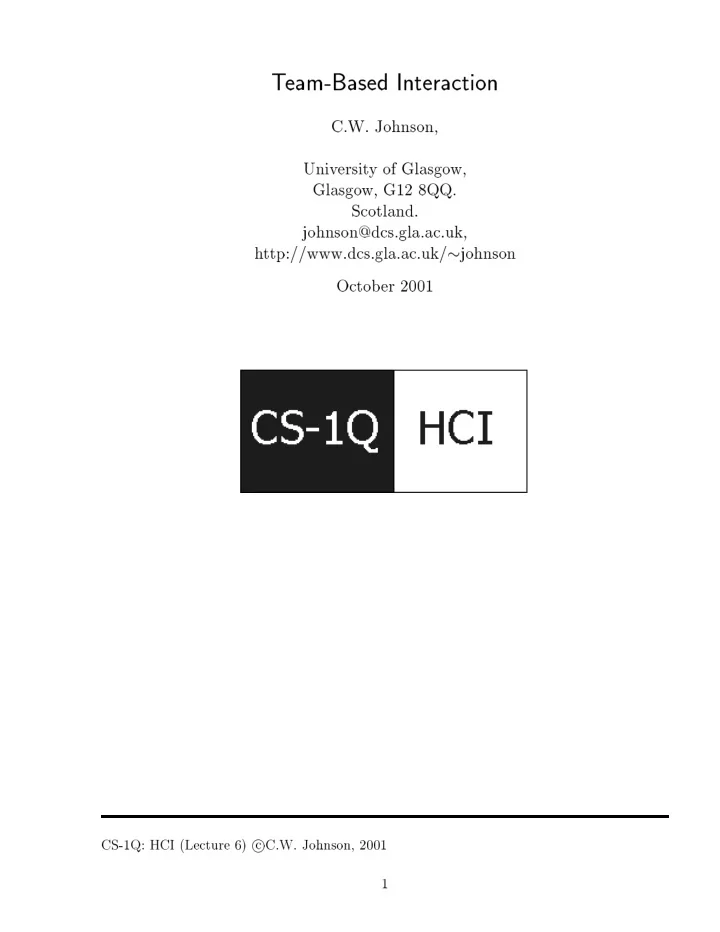

T eam-Based Interaction C.W. Johnson, Univ ersit y of Glasgo w, Glasgo w, G12 8QQ. Scotland. johnson@dcs.gla.ac.uk, h ttp://www.dcs.gla .a c.uk/ � johnso n Octob er 2001 c CS-1Q: HCI (Lecture 6) � C.W. Johnson, 2001 1
T eam-Based Interaction Computer-Supp o rted Co op erative W o rk. � Ac kno wledgemen t: Shrimp pro ject Synchronous vs Asynchronous interaction. � Cla rk, Brennan and Common Ground. � c CS-1Q: HCI (Lecture 6) � C.W. Johnson, 2001
Problems of Group w o rk Why is group w o rk di�cult? � Distraction: � - individual interrupts colleague's tasks. Group co o rdination failures: � - overhead of co o rdinating group actions impairs group. Group planning and management failures: � - groups create unnecessa ry tasks. Excessive in�uence of the leader: � - high status leader sti�e contra ry opinions. Group p ola risation and groupthink: � - group p ersuaded b y dillusions of its o wn invulnerabilit y . c CS-1Q: HCI (Lecture 6) � C.W. Johnson, 2001
Problems of Group w o rk Computers mak e things w o rse. � F ree-riders: \it's lost in the mail". � Distractions and group planning: � - encysting can b e a p roblem. In�uence of the leader: � - can `freeze' p eople out of video-conferences. Group co o rdination much w o rse: � - \can y ou all hea r me?". c CS-1Q: HCI (Lecture 6) � C.W. Johnson, 2001
Computer-Supp o rted Co op erative W o rk (CSCW). F ace to face: same place, same time. � Synchronous: di�erent place, same time. � Asynchronous (1): di�erent place, di�erent time. � Asynchronous (2): same place, di�erent time. � c CS-1Q: HCI (Lecture 6) � C.W. Johnson, 2001
F ace to F ace Applications: � - sha re a computer to reco rd design decisions; - use computer to sha re visualisations. Ac kno wledgemen t: F acult y of Science, Lough b orough Univ. Fighting over access to the input devices? � One p erson thinks while the other t yp es 8( � c CS-1Q: HCI (Lecture 6) � C.W. Johnson, 2001
Asynchronous CSCW Relatively simple add-on to existing systems. � Need fo r version control on sha red objects. � c CS-1Q: HCI (Lecture 6) � C.W. Johnson, 2001
Asynchronous CSCW Applications: � - electronic mail, new and bulletin b oa rds; - increasingly used to p rovide 24 hour cover. Need to establish the context of messages: � - rememb er that messages will a rrive out of o rder; - threads in p ostings and use of in mail. Re: c CS-1Q: HCI (Lecture 6) � C.W. Johnson, 2001
Synchronous CSCW Integrate di�erent mo des of communication. � Applications: � - NetMeeting and video conferencing; - sha red editing to ols and CAD/CAM systems; - games and MUDS (multi-user dungeons). c CS-1Q: HCI (Lecture 6) � C.W. Johnson, 2001
Synchronous CSCW Need access control mechanisms. � Ac kno wledgemen t: Shrimp Pro ject Tw o t yp es: � - so cial convention (`after y ou...'); - technological (lo cking systems). c CS-1Q: HCI (Lecture 6) � C.W. Johnson, 2001
Synchronous CSCW Access rates: � - b etter links/equipment give b etter resp onse; - this can have so cial/interaction e�ects. F rsutration over dela ys: � - jitter and qualit y of service. Need fo r con�ict resolution: � - lo ck object while y ou a re w o rking on it? - allo w concurrent edits then resolve con�icts? c CS-1Q: HCI (Lecture 6) � C.W. Johnson, 2001
Common Ground Cla rk and Brennan: � - conversations to establish common ideas. Cost Description F orm ulation form ulate and reform ulate utterances Pro duction pro ducing the utterance Reception receiving a message Understanding understanding a message Start-up starting a new discourse Dela y planning and revising b efore execution Async hron y timing of discourse exc hanges Sp eak er c hange c hanging sp eak ers Displa y presen ting an ob ject of the discourse F ault pro ducing a mistak e Repair repairing a mistak e If y ou sa y something but a re misundersto o d then � - y ou have to initiate a repair conversation; - this is the cost of establishing common ground. c CS-1Q: HCI (Lecture 6) � C.W. Johnson, 2001
Common Ground Analyse transcripts to supp o rt design. � Problems with sp eak er change: � - consider dialogue control measures? - lo ok again at lo cking techniques? Lots of repair activities: � - p rovide greater view of colleague's w o rk? - p ossibly add video to audio communications? Problems with dela y: � - must see changes made while planning last message? c CS-1Q: HCI (Lecture 6) � C.W. Johnson, 2001
Summa ry Problems of group w o rk. � Computer-Supp o rted Co op erative W o rk: � - face to face interaction; - synchronous interaction; - asynchronous interaction. Cla rk, Brennan and Common Ground. � c CS-1Q: HCI (Lecture 5) � C.W. Johnson, 2001
F urther Reading Shneiderman on: � - CSCW - pp. 477-502. c CS-1Q: HCI (Lecture 6) � C.W. Johnson, 2001
Recommend
More recommend